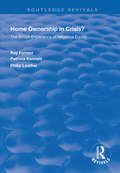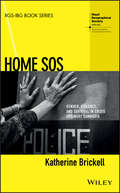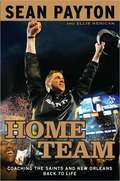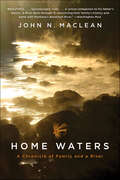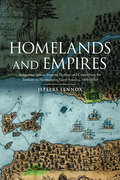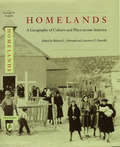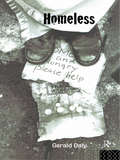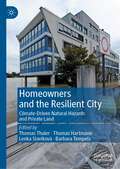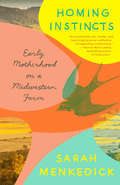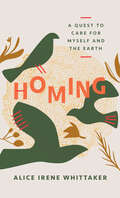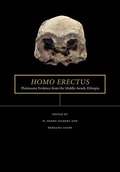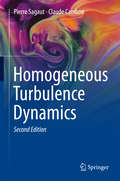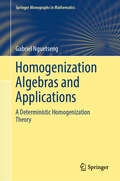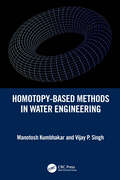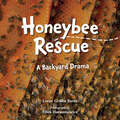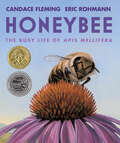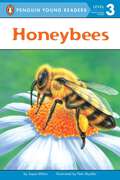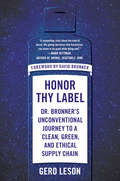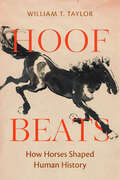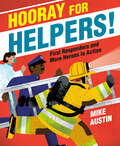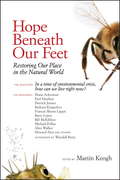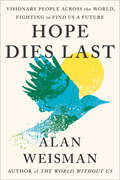- Table View
- List View
Home Ownership in Crisis?: The British Experience of Negative Equity (Routledge Revivals)
by Ray Forrest Patricia Kennett Philip LeatherFirst published in 1999, this book brings together the findings from research projects funded by the Joseph Rowntree Foundation and the Department of the Environment, Transport and the Regions. The programme of research examined the problems faced by home owners with the collapse of the property market in the late 1980s. The book focuses on households with negative equity and uses analyzes of secondary data sets, social surveys and in-depth interviews to explore the implications of the fall in property values for both households and the wider economy. In particular it examines the kinds of coping strategies adopted by home owners in relation to debt and mobility. Home Ownership in Crisis? thus gets beyond aggregate estimates and offers the reader a detailed understanding of what negative equity actually means for the individuals concerned. Moreover, by exposing a range of circumstances in which negative equity arises, the book also informs debates about the kinds of policy initiatives which may be appropriate in dealing with a more volatile economic environment in Britain and elsewhere.
Home SOS: Gender, Violence, and Survival in Crisis Ordinary Cambodia (RGS-IBG Book Series)
by Katherine BrickellDrawing on 15 years of fieldwork and over 300 interviews, Home SOS argues that the home is central to the violence and gendered contingency of existence in crisis ordinary Cambodia. Provides an original book-length study which brings domestic violence and forced eviction into twin view Offers relational insights between different violences to build an integrated understanding of women’s experiences of home life Mobilises the crisis ordinary as a critical pedagogy and imaginary through which to understand everyday gendered politics of survival Positions domestic violence and forced eviction as manifestations of intimate war against women’s homes and bodies located inside and outside of the traditional purview of war Reaffirms and reprioritises the home as a political entity which is foundational to the concerns of human geography
Home Team: Coaching the Saints and New Orleans Back to Life
by Sean Payton Ellis HenicanA story of a city recovering from disaster of Hurricane Katrina and a team with a history of heartbreak. The inspirational true story tells how one man led a football team-- and a city-- to triumph in Super Bowl XLIV.
Home Waters: A Chronicle of Family and a River
by John N. Maclean“Beautiful. ... A lyrical companion to his father’s classic, A River Runs through It, chronicling their family’s history and bond with Montana’s Blackfoot River.” —Washington PostA "poetic" and "captivating" (Publishers Weekly) memoir about the power of place to shape generations, Home Waters is John N. Maclean's remarkable chronicle of his family's century-long love affair with Montana's majestic Blackfoot River, the setting for his father's classic novella, A River Runs through It. Maclean returns annually to the simple family cabin that his grandfather built by hand, still in search of the trout of a lifetime. When he hooks it at last, decades of longing promise to be fulfilled, inspiring John, reporter and author, to finally write the story he was born to tell. A book that will resonate with everyone who feels deeply rooted to a landscape, Home Waters is a portrait of a family who claimed a river, from one generation to the next, of how this family came of age in the 20th century and later as they scattered across the country, faced tragedy and success, yet were always drawn back to the waters that bound them together. Here are the true stories behind the beloved characters fictionalized in A River Runs through It, including the Reverend Maclean, the patriarch who introduced the family to fishing; Norman, who balanced a life divided between literature and the tug of the rugged West; and tragic yet luminous Paul (played by Brad Pitt in Robert Redford’s film adaptation), whose mysterious death has haunted the family and led John to investigate his uncle’s murder and reveal new details in these pages.A universal story about nature, family, and the art of fly fishing, Maclean’s memoir beautifully captures the inextricable ways our personal histories are linked to the places we come from—our home waters. Featuring twelve wood engravings by Wesley W. Bates and a map of the Blackfoot River region.
Homegrown & Handmade: A Practical Guide to More Self-Reliant Living
by Deborah NiemannThe author of Ecothrifty shows you how to life more self-sufficiently with her guide to modern homesteading―no farm required.Food recalls, dubious health claims, scary and shocking ingredients in health and beauty products. Our increasingly industrialized supply system is becoming more difficult to navigate, more frightening, and more frustrating, leaving us feeling stuck choosing in many cases between the lesser of several evils. That&’s why author Deborah Niemann is here to offer healthier, more empowering choices, by showing us how to reclaim links in our food and purchasing chains, to make choices that are healthier for our families, ourselves, and our planet.In this fully updated and revised edition of Homegrown and Handmade, Deborah shows how making things from scratch and growing some of your own food can help you eliminate artificial ingredients from your diet, reduce your carbon footprint, and create a more authentic life.Whether your goal is increasing your self-reliance or becoming a full-fledged homesteader, this book is packed with answers and solutions to help you rediscover traditional skills, take control of your food from seed to plate, and much more. This comprehensive guide to food and fiber from scratch proves that attitude and knowledge is more important than acreage. Written from the perspective of a successful, self-taught modern homesteader, this well-illustrated, practical, and accessible manual will appeal to anyone who dreams of a more empowered life.&“Dreaming of a mindful life? Niemann&’s advice on gardening, cooking, orcharding, raising livestock, and much more demonstrates that it&’s possible to begin the journey in your own backyard.&” —Rebecca Martin, Managing Editor, Mother Earth News
Homelands and Empires: Indigenous Spaces, Imperial Fictions, and Competition for Territory in Northeastern North America, 1690–1763
by Jeffers LennoxThe period from 1690 to 1763 was a time of intense territorial competition during which Indigenous peoples remained a dominant force. British Nova Scotia and French Acadia were imaginary places that administrators hoped to graft over the ancestral homelands of the Mi’kmaq, Wulstukwiuk, Passamaquoddy, and Abenaki peoples. Homelands and Empires is the inaugural volume in the University of Toronto Press’s Studies in Atlantic Canada History. In this deeply researched and engagingly argued work, Jeffers Lennox reconfigures our general understanding of how Indigenous peoples, imperial forces, and settlers competed for space in northeastern North America before the British conquest in 1763. Lennox’s judicious investigation of official correspondence, treaties, newspapers and magazines, diaries, and maps reveals a locally developed system of accommodation that promoted peaceful interactions but enabled violent reprisals when agreements were broken. This outstanding contribution to scholarship on early North America questions the nature and practice of imperial expansion in the face of Indigenous territorial strength.
Homelands: A Geography of Culture and Place across America (Creating the North American Landscape)
by Richard L. Nostrand Lawrence E. EstavilleWhat does it mean to be from somewhere? If most people in the United States are "from some place else" what is an American homeland? In answering these questions, the contributors to Homelands: A Geography of Culture and Place across America offer a geographical vision of territory and the formation of discrete communities in the U.S. today. Homelands discusses groups such as the Yankees in New England, Old Order Amish in Ohio, African Americans in the plantation South, Navajos in the Southwest, Russians in California, and several other peoples and places. Homelands explores the connection of people and place by showing how aspects of several different North American groups found their niche and created a homeland. A collection of fifteen essays, Homelands is an innovative look at geographical concepts in community settings. It is also an exploration of the academic work taking place about homelands and their people, of how factors such as culture, settlement, and cartographic concepts come together in American sociology. There is much not only to study but also to celebrate about American homelands. As the editors state, "Underlying today's pluralistic society are homelands—large and small, strong and weak—that endure in some way. The mosaic of homelands to which people bonded in greater or lesser degrees, affirms in a holistic way America's diversity, its pluralistic society." The authors depict the cultural effects of immigrant settlement. The conviction that people need to participate in the life of the homeland to achieve their own self realization, within the traditions and comforts of that community. Homelands gives us a new map of the United States, a map drawn with people's lives and the land that is their home.
Homeless: Policies, strategies and Lives on the Streets
by Gerald DalyThe causes of homelessness are disputed by both Right and Left. But, few would argue that life on the streets is anything other than dangerous and debilitating. Unemployment, deinstitutionalisation, abuse in the home are among the stories the homeless tell. Voluntary organisations point to the failure of emergency shelters and food banks, the cut-backs in social programmes and the severe shortage of affordable housing. On the international scale, the changing global system has placed new demands on the economies of Europe and north America which have impacted on resources, employment and even political will. This book is the first comprehensive international study of homelessness. The author argues that the category of the homeless must itself be broadened, to encompass those chronically without shelter to those in immediate risk of dispossession, if homelessness is to be tackled effectively (before and after it happens) by public policy, voluntary organisations and the individuals themselves.
Homeowners and the Resilient City: Climate-Driven Natural Hazards and Private Land
by Thomas Thaler Thomas Hartmann Lenka Slavíková Barbara TempelsThis book provides an important overview of how climate-driven natural hazards like river or pluvial floods, droughts, heat waves or forest fires, continue to play a central role across the globe in the 21st century. Urban resilience has become an important term in response to climate change. Resilience describes the ability of a system to absorb shocks and depends on the vulnerability and recovery time of a system. A shock affects a system to the extent that it becomes vulnerable to the event. This book focus examines how private property-owners might implement such measures or improve their individual coping and adaptive capacity to respond to future events. The book looks at the existence of various planning, legal, financial incentives and psychological factors designed to encourage individuals to take an active role in natural hazard risk management and through the presentation of theoretical discussions and empirical cases shows how urban resilience can be achieved. In addition, the book guides the reader through different conceptual frameworks by showing how urban regions are trying to reach urban resilience on privately-owned land. Each chapter focuses on different cultural, socio-economic and political backgrounds to demonstrate how different institutional frameworks have an impact.
Homing Instincts: Early Motherhood on a Midwestern Farm
by Sarah MenkedickSarah Menkedick spent her twenties trekking alone across South America, teaching English to recalcitrant teenagers on Reunion Island, picking grapes in France and camping on the Mongolian grasslands; for her, meaning and purpose were to be found on the road, in flight from the ordinary. Yet the biggest and most transformative adventure of her life might be one she never anticipated: at 31, she moves into a tiny 19th-century cabin on her family's Ohio farm, and begins the journey into motherhood. In eight vivid and boldly questioning essays, Menkedick explores the luminous, disorienting time just before and after becoming a mother. As she reacquaints herself with the subtle landscapes of the Midwest, and adjusts to the often surprising physicality of pregnancy, she ruminates on what this new stage of life means for her long-held concepts of self, settling, and creative fulfillment. In “Millie, Mildred, Grandma Menkedick,” she considers the nature of story through the life of her tough German grandmother, who raised two boys as a single mother in the 1950s and then spent her seventies traveling the world with her best friend Marge; in “Motherland,” on a trip back to Oaxaca, Mexico to visit her husband’s family, she finally embraces her Midwestern roots; in “The Milk Cave,” she discovers in breastfeeding a new appreciation for the spiritual and artistic potential of boredom; and in “The Lake,” she revisits her childhood with her father, whose relentless optimism and mystical streak she sees anew once she has a child of her own. A story of a traveler come home to the farm; of becoming a mother in spite of reservations and doubt; and of learning to appreciate the power and beauty of the quotidian, Homing Instincts speaks to the deepest concerns and hopes of a generation.
Homing: A Quest to Care for Myself and the Earth
by Alice Irene WhittakerA memoir about abandoning an exhausting commuter lifestyle to move to a cabin in the woods, embracing imperfection while cultivating a life of care for self and nature.Alice Irene Whittaker was addicted to productivity, perfectionism, and discipline, making sure that every single moment of the day was accounted for. Then she finds herself as a new mother, commuting four hours a day into the city, exhausted by the state of the world, paralyzed by climate guilt and anxiety. Overnight, Alice Irene and her family decide to retreat to a cabin in the woods, in search of a new kind of life. Surrounded by creek, meadow, and forest, Alice Irene begins a new lifelong journey of repairing her fractured relationship with both herself and the natural world. Her quest takes her to meet a renowned economist-rancher in Colorado, to stand at the side of a runway at a sustainable fashion show in Portland, and to witness firsthand rewilding of wolves in Yellowstone. She interviews and learns from dozens of people who are building homes, growing food, making clothes, raising families, and living their lives in regenerative ways. Searching for the spaces between the sorrow of wildfires and the beauty of wildflowers, Homing is a lyrical memoir about moving from a life of despair to a life of care.
Homo Erectus: Pleistocene Evidence from the Middle Awash, Ethiopia
by W. Henry Gilbert Berhane AsfawThis book provides the first detailed descriptions, photographs, and analysis of the fossil vertebrates--from elephants and hyenas to humans--from the Daka Member of the Bouri Formation of the Afar, a place renowned for an abundant and lengthy record of human ancestors.
Homogeneous Turbulence Dynamics
by Pierre Sagaut Claude CambonThis book provides state-of-the-art results and theories in homogeneous turbulence, including anisotropy and compressibility effects with extension to quantum turbulence, magneto-hydodynamic turbulence and turbulence in non-newtonian fluids. Each chapter is devoted to a given type of interaction (strain, rotation, shear, etc.), and presents and compares experimental data, numerical results, analysis of the Reynolds stress budget equations and advanced multipoint spectral theories. The role of both linear and non-linear mechanisms is emphasized. The link between the statistical properties and the dynamics of coherent structures is also addressed. Despite its restriction to homogeneous turbulence, the book is of interest to all people working in turbulence, since the basic physical mechanisms which are present in all turbulent flows are explained. The reader will find a unified presentation of the results and a clear presentation of existing controversies. Special attention is given to bridge the results obtained in different research communities. Mathematical tools and advanced physical models are detailed in dedicated chapters.
Homogenization Algebras and Applications: A Deterministic Homogenization Theory (Springer Monographs in Mathematics)
by Gabriel NguetsengThe book presents a deterministic homogenization theory intended for the mathematical analysis of non-stochastic multiscale problems, both within and beyond the periodic setting. The main tools are the so-called homogenization algebras, the classical Gelfand representation theory, and a class of actions by the multiplicative group of positive real numbers on numerical spaces. The basic approach is the Sigma-convergence method, which generalizes the well-known two-scale convergence procedure. Numerous problems are worked out to illustrate the theory and highlight its broad applicability. The book is primarily intended for researchers (including PhD students) and lecturers interested in periodic as well as non-periodic homogenization theory.
Homotopy-Based Methods in Water Engineering
by Vijay P. Singh Manotosh KumbhakarMost complex physical phenomena can be described by nonlinear equations, specifically, differential equations. In water engineering, nonlinear differential equations play a vital role in modeling physical processes. Analytical solutions to strong nonlinear problems are not easily tractable, and existing techniques are problem-specific and applicable for specific types of equations. Exploring the concept of homotopy from topology, different kinds of homotopy-based methods have been proposed for analytically solving nonlinear differential equations, given by approximate series solutions. Homotopy-Based Methods in Water Engineering attempts to present the wide applicability of these methods to water engineering problems. It solves all kinds of nonlinear equations, namely algebraic/transcendental equations, ordinary differential equations (ODEs), systems of ODEs, partial differential equations (PDEs), systems of PDEs, and integro-differential equations using the homotopy-based methods. The content of the book deals with some selected problems of hydraulics of open-channel flow (with or without sediment transport), groundwater hydrology, surface-water hydrology, general Burger’s equation, and water quality. Features: Provides analytical treatments to some key problems in water engineering Describes the applicability of homotopy-based methods for solving nonlinear equations, particularly differential equations Compares different approaches in dealing with issues of nonlinearity
Honey Bees: Letters from the Hive
by Stephen BuchmannA fascinating look at the story of bees, the many extraordinary and often unexpected ways they've enriched our lives from prehistoric times to today, and their importance in keeping the food chain thriving. This is the perfect book for honey lovers young and old, as well as a great choice for middle and high school book reports or for use as a resource for science projects. Readers will be taken into the hive-one part nursery, one part honey factory, one part queen's inner sanctum-then fly through backyard gardens, open fields, and deserts where wildflowers bloom. It's fascinating and delicious! For honey fanatics and all who have a sweet tooth, this book not only entertains and enlightens but also reminds us of the fragility of humanity's relationship with nature.
Honeybee Rescue: A Backyard Drama
by Loree BurnsFans of the Scientists in the Field series will love discovering ways to save and protect bees through the eyes of a honeybee rescuer. Follow honeybee rescuer Mr. Nelson as he expertly removes a colony of bees from Mr. Connery's barn (with a vacuum!) and helps it relocate back to a hive. Photographs of Mr.Nelson’s relocation of the colony help bring the honeybee rescue to life. <P><P> Nature lovers and scientists-to-be will be abuzz as they learn all the ways to keep honeybees (and our ecosystem) safe. <P><P><i>Advisory: Bookshare has learned that this book offers only partial accessibility. We have kept it in the collection because it is useful for some of our members. Benetech is actively working on projects to improve accessibility issues such as these.</i>
Honeybee: The Busy Life of Apis Mellifera
by Candace FlemingRobert F. Sibert Medal Winner Take to the sky with Apis, one honeybee, as she embarks on her journey through life!An Orbis Pictus Honor BookSelected for the Texas Bluebonnnet Master ListFinalist for the AAAS/Subaru SB&F Prize for Excellence in Science Books A tiny honeybee emerges through the wax cap of her cell. Driven to protect and take care of her hive, she cleans the nursery and feeds the larvae and the queen. But is she strong enough to fly? Not yet! Apis builds wax comb to store honey, and transfers pollen from other bees into the storage. She defends the hive from invaders. And finally, she begins her new life as an adventurer. The confining walls of the hive fall away as Apis takes to the air, finally free, in a brilliant double-gatefold illustration where the clear blue sky is full of promise-- and the wings of dozens of honeybees, heading out in search of nectar to bring back to the hive. Eric Rohmann's exquisitely detailed illustrations bring the great outdoors into your hands in this poetically written tribute to the hardworking honeybee. Award-winning author Candace Fleming describes the life cycle of the honeybee in accessible, beautiful language. Similar in form and concept to the Sibert and Orbis Pictus award book Giant Squid, Honeybee also features a stunning gatefold and an essay on the plight of honeybees.Cook Prize Honor BookA Kids' Book Choice Award FinalistAn American Library Association Notable Children&’s BookA New York Public Library Best Book of the YearNamed a Best Book of the Year by Kirkus Reviews, NPR, Shelf Awareness, School Library Journal, Publishers Weekly and more!A Horn Book Fanfare Best Book of the YearA Bank Street Best Children's Book of the Year!A Bulletin of the Center for Children's Books Blue Ribbon BookA Booklist Editor's ChoiceNamed to the Texas Topaz Reading ListA Junior Library Guild Gold Standard Selection
Honeybees (Penguin Young Readers, Level 3)
by Joyce MiltonBzzz! Learn all about the life cycle of honeybees, how they make honey, and more. With fun bee facts and bright, realistic artwork, this Station Stop 2 easy reader will fly off bookshelves!Illustrated by Pete Mueller.
Honor Thy Label: Dr. Bronner's Unconventional Journey to a Clean, Green, and Ethical Supply Chain
by Gero Leson&“A compelling story about the kind of moral, life-giving decisions that businesses can make to do good while doing well.&”—Mark Bittman, author of Animal, Vegetable, JunkWhat's in a label? For Dr. Bronner's, more than ingredients or intentions—it spells out an ethical commitment to fairness and sustainable growth, uniting consumers and companies worldwide. Dr. Bronner&’s Magic Soaps are renowned for their dense product labels (&“All-One!&”) and the curious tingling of peppermint. But how did this unusual natural soap transform the small print into soaring sales—inspiring customer loyalty not just with lather, but with good clean business? In Honor Thy Label, Dr. Bronner&’s head of Special Operations, Gero Leson, reveals the inside story of how a little-known family-run soap company grew from countercultural roots to create a revolutionary fair trade and organic supply chain from the ground up—and rode the waves of popular demand without losing sight of the process. Through stories of harrowing setbacks and hard-won triumphs in projects that spanned the globe, in Sri Lanka, Ghana, India, and beyond, Leson demystifies the process of building and scaling ethical production. And he proves that if done right, the results ripple outward to benefit customers, communities, and the environment we share. Told with spirit and conviction, Honor Thy Label invites socially conscious entrepreneurs and shoppers on a journey to break the boundaries of production with the pioneers of socially just business—spreading Dr. Bronner&’s radical vision of simple ingredients with cosmic impact.
Hoof Beats: How Horses Shaped Human History
by William T. TaylorJourney to the ancient past with cutting-edge science and new data to discover how horses forever altered the course of human history. From the Rockies to the Himalayas, the bond between horses and humans has spanned across time and civilizations. In this archaeological journey, William T. Taylor explores how momentous events in the story of humans and horses helped create the world we live in today. Tracing the horse's origins and spread from the western Eurasian steppes to the invention of horse-drawn transportation and the explosive shift to mounted riding, Taylor offers a revolutionary new account of how horses altered the course of human history. Drawing on Indigenous perspectives, ancient DNA, and new research from Mongolia to the Great Plains and beyond, Taylor guides readers through the major discoveries that have placed the horse at the origins of globalization, trade, biological exchange, and social inequality. Hoof Beats transforms our understanding of both horses and humanity's ancient past and asks us to consider what our relationship with horses means for the future of humanity and the world around us.
Hooray for Helpers!: First Responders and More Heroes in Action
by Mike AustinCelebrate first responders in this timely, action-packed picture book featuring firefighters, doctors, EMTs, and other brave helpers in action!First responders are on the way! Every day, brave helpers are on full alert, ready to rescue people and animal friends in need. They work on land, go underground, and even parachute down from the sky. Buckle up and cheer for these heroes as they go the distance to keep everyone safe.With bright, colorful art and labels of rescue vehicles and equipment in the style of Richard Scarry, this introduction to and celebration of first responders packs FUN and FACTS. Look inside for a Q&A with a real firefighter and an emergency supplies list!Ready for more action? Check out Fire Engine No. 9 and Rescue Squad No. 9!
Hope Beneath Our Feet: Restoring Our Place in the Natural World
by Barbara Kingsolver Alice Walker Howard Zinn Michael Pollan Martin KeoghThe environmental "tipping point" we approach is more palpable each day, and people are seeing it in ways they can no longer ignore--we need only turn on the news to hear the litany of what is wrong around us. Serious reflection, inspiration, and direction on how to approach the future are now critical. Hope Beneath Our Feet creates a space for change with stories, meditations, and essays that address the question, "If our world is facing an imminent environmental catastrophe, how do I live my life right now?" This collection provides tools, both practical and spiritual, to those who care about our world and to those who are just now realizing they need to care. Featuring prominent environmentalists, artists, CEOs, grassroots activists, religious figures, scientists, policy makers, and indigenous leaders, Hope Beneath Our Feet shows readers how to find constructive ways to channel their energies and fight despair with engagement and participation. Presenting diverse strategies for change as well as grounds for hope, the contributors to this anthology celebrate the ways in which we can all engage in beneficial action for ourselves, our communities, and the world.Contributors include: Diane Ackerman, Paul Hawken, Derrick Jensen, Barbara Kingsolver, Francis Moore Lappé, Barry Lopez, Bill McKibben, Michael Pollan, Alice Walker, Howard Zinn.
Hope Diamond: The Legendary History of a Cursed Gem
by Richard Kurin David J. SkortonThe true story behind the most famous-and infamous-stone in the world. The Hope diamond is not only exceptionally beautiful it has a long and incredibly colorful history. That history - spread over three continents - features diamond mining in India, the French Revolution, the machinations of British King George IV, the Gilded Age in America and a number of very clever jewelers including Pierre Cartier and Harry Winston. In the 20th century, the myth of the Hope diamond curse made the diamond more notorious and famous than ever before, but it is only one small piece of a long and lustrous history. Dr. Kurin, who is a cultural anthropologist, has spent over a decade on the trail of the Hope, from India, to France, Germany, Russia, Switzerland, and England. His narrative is filled with fascinating places and people - from the fabled diamond city of Golconda to the fabulously rich heiress Evalyn McLean to Jackie Kennedy and her pivotal role in one of the Hopes few 20th century trips abroad.
Hope Dies Last: Visionary People Across the World, Fighting to Find Us a Future
by Alan WeismanOne of Heatmap's 18 Climate Books to Read in 2025The award-winning environmental journalist&’s extraordinary, long-awaited portrait of hope and resilience as we face a fractured and uncertain futureIn this profoundly human and moving narrative, the bestselling author of The World Without Us returns with a book ten years in the making: a study of what it means to be a human on the front lines of our planet&’s existential crisis. His new book, Hope Dies Last, is a literary evocation of our current predicament and the core resolve of our species against the most precarious odds we have ever faced.To write this book, Weisman traveled the globe, witnessing climate upheaval and other devastations, and meeting the people striving to mitigate and undo our past transgressions. From the flooding Marshall Islands to revived wetlands in Iraq, from the Netherlands and Bangladesh to the Korean DMZ and to cities and coastlines in the U.S. and around the world, he has encountered the best of humanity battling heat, hunger, rising tides, and imperiled nature. He profiles the innovations of big thinkers—engineers, scientists, conservationists, economists, architects, and artists—as they conjure wildly creative, imaginative responses to an uncertain, ominous future. At this unprecedented point in history, as our collective exploits on this planet may lead to our own undoing and we could be among the species marching toward extinction, they refuse to accept defeat.Hope Dies Last fills a crucial gap in the global conversation: Having reached a point of no return in our climate confrontation, how do we feel, behave, act, plan, and dream as we approach a future decidedly different from what we had expected?
